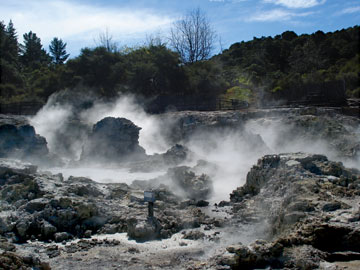|
NEWS NOTES
New methane-munching bacteria discovered
 Peter Dunfield |
| New species of microbes were recently found in Hell’s Gate, a region in New Zealand that hosts geothermal mud pools. |
Methane levels in the atmosphere are minute compared to the popular villain of climate change: carbon dioxide. But methane is more than 20 times more effective at trapping heat than carbon dioxide, making it a very important greenhouse gas. So far, however, many of the processes that influence how much methane reaches the atmosphere and how much is consumed on Earth — mainly by microbes that use the gas as an energy and carbon source — are unclear. Now scientists have discovered two previously unknown players in the global methane cycle. Unlike other known methane munchers, the new bacteria belong to the Verrucomicrobia phylum. Members of this phylum are found all over Earth, pointing scientists in new directions to look for more of the microbes.
Two separate papers in the Dec. 6 Nature describe two methane-consuming bacteria that thrive in some of the harshest conditions on Earth — such as in mud pools in the Solfatara volcano near Naples, Italy, and in the soil of the Hell’s Gate geothermal area of New Zealand. These newly discovered bacteria tolerate much more acidic conditions and have a different physiology than any methane-consuming bacteria known so far, says Gary King of Louisiana State University in Baton Rouge, who was not involved in the research. “That’s telling us that there is more to the story than we thought,” he says.
One important question to answer is whether variants of the newly found organisms live in other, more common methane-producing environments, such as peatlands and acidic wetlands, King says. “Such areas play a significant part in the methane budget and may become even more critical in a future that is warmer than today.” Knowing how such bacteria respond to changing environmental conditions, such as rising temperatures and carbon dioxide levels, is critical for predicting changes to the methane cycle, he says.
It’s also important to understand how these bacteria are affected by human activity, says Peter Dunfield of the University of Calgary in Canada, lead author of one of the papers. For example, shallow geothermal areas such as the one where he and his team found one of the new bacteria are prime sites for geothermal power generation. “But if you were to develop a plant there, you could be bypassing this microbial filter and start pumping the gas directly into the atmosphere,” he says. “It would be important to get the bacterium back into the loop somehow.”
Although scientists have a lot left to learn about the methane cycle, these new discoveries help, King says. “These two papers are among the most significant recent contributions to the field,” he says, “and they show us that there is a whole new area to explore.”

 Subscribe
Subscribe


